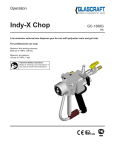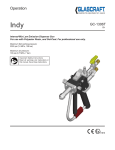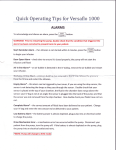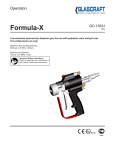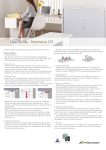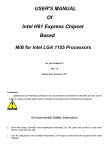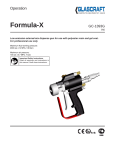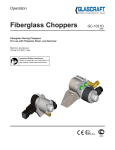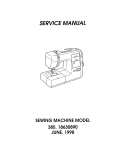Download GC-1367L - Indy-X, Operation, English - Graco
Transcript
Operation Indy-X GC-1367L EN Low emission external-mix dispense gun for use with polyester resin and gel coat. For professional use only. Maximum fluid working pressure: 2000 psi (14 MPa, 138 bar) Maximum air pressure: 100 psi (0.7 MPa, 7 bar) Important Safety Instructions Read all warnings and instructions in this manual. Save these instructions. II 2 G Contents Warnings........................................................................ 3 Important Safety Information....................................... 5 Grounding...................................................................... 6 Set-Up............................................................................. 7 Parts............................................................................... 8 Pressure Relief Procedure......................................... 13 Maintenance................................................................. 14 Options......................................................................... 21 Technical Data.............................................................. 25 Graco Ohio Standard Warranty.................................. 26 Graco Ohio Information.............................................. 26 2 GC-1367K Warnings The following warnings are for the setup, use, grounding, maintenance, and repair of this equipment. The exclamation point symbol alerts you to a general warning and the hazard symbol refers to procedurespecific risk. Refer back to these warnings. Additional, product-specific warnings may be found throughout the body of this manual where applicable. • See Important Safety Information - MEKP, Polyester Resins and Gel-Coats and Spraying and Lamination Operations section of this manual. Changing Materials WARNING FIRE AND EXPLOSION HAZARD Changing FlammableMaterials fumes, such as solvent and paint fumes, in work area can ignite or explode. To help • prevent fire and explosion: When changing materials, flush the equipment mul• Use equipment only in well ventilated area. tiple times to ensure it is thoroughly clean. • • • • • Eliminate all ignition sources; such as pilot lights, cigarettes, portable electric lamps, and plastic drop cloths (potential static arc). Always •clean thework fluid area inlet free strainers afterincluding flushing.solvent, rags and gasoline. Keep of debris, • Do not plug or unplug power cords, or turn power or light switches on or off when flammable Check with fumes your material manufacturer for chemical are present. compatibility. • Ground all equipment in the work area. See Grounding instructions. • Use only grounded hoses. • Holduse gunISO firmly side of grounded pailuse when triggering into pail. Most materials ontothe A side, but some • If there is static sparking or you feel a shock, stop operation immediately. Do not use equipment ISO on the B side. until you identify and correct the problem. • Keep a working fire extinguisher in the work area. Epoxies often have amines on the B (hardener) side. Polyureas often have amines on the B (resin) PERSONAL PROTECTIVE EQUIPMENT side. You must wear appropriate protective equipment when operating, servicing, or when in the operating area of the equipment to help protect you from serious injury, including eye injury, inhalation of toxic fumes, burns, and hearing loss. This equipment includes but is not limited to: • Protective eyewear • Clothing and respirator as recommended by the fluid and solvent manufacturer • Gloves This section• is used withprotection some RAM plates which could get pushed out of the drums of sealant. Hearing Splatter Hazard TOXIC FLUID OR FUMES HAZARD Toxic fluids or fumes can cause serious injury or death if splashed in the eyes or on skin, inhaled, or swallowed. • Read MSDS’s to know the specific hazards of the fluids you are using. • Store hazardous fluid in approved containers, and dispose of it according to applicable SPLATTER HAZARD guidelines. Hot toxic wear fluid can cause serious injuryspraying if splashed in the eyes or on skin. During blow off of platen, • or Always impervious gloves when or cleaning equipment. WARNING splatter may occur. • Use minimum air pressure when removing platen from drum. Burn Hazard For equipment used with heated material. GC-1367K 3 Skin Injection Hazard Use with high pressure equipment, generally equipment with pressure rating of 900 psi or higher. There sions of this section. 1) manual guns, 2) UL-1450 compliant equipment 3) automatic guns,/dispense val tion valves, 4) heated hoses. Since the text contains mostly “Do not” statements, the symbols have lines them. Warnings WARNING WARNING SKININJECTION INJECTION HAZARD - Basic SKIN HAZARD High-pressure fluid from gun, hose ruptured will pierce skin.will Thispierce may look High-pressure fluid from gun,leaks, hoseorleaks, orcomponents ruptured components skin. This may l like just a cut, but it is a serious injury that can result in amputation. Get immediate surgical a cut, but it is a serious injury that can result in amputation. Get immediate surgical treatm treatment. • Do not point gun at anyone or at any part of the body. • Do not point gun at anyone or at any part of the body. over the spray •• DoDo notnot put put youryour hand hand over the dispense outlet. tip. or deflect leaks your hand, •• DoDo notnot stopstop or deflect leaks with yourwith hand, body, glove,body, or rag.glove, or rag. •• Follow Pressure Relief Procedure in this manual, when you installed. stop spraying and before cleaning, Do not spray without tip guard and trigger guard checking, or servicing equipment. • Engage trigger lock when not spraying. • Follow Pressure Relief Procedure in this manual, when you stop spraying and before c checking, or servicing equipment. MOVING PARTS HAZARD SKIN INJECTION HAZARD - Use with UL1450 Compliance Moving parts can pinch or amputate fingers and other body parts. not aim gun at,parts. or spray any person or animal. •DoKeep clearthe of moving •• DoKeep not operate with protective covers handsequipment and other body partsguards awayor from theremoved. discharge. For example, do not try to sto • Pressurized equipment can start without warning. Before checking, moving, or servicing any part of the body. equipment, follow the Pressure Relief Procedure in this manual. Disconnect power or air • Always use the nozzle tip guard. Do not spray without nozzle tip guard in place. supply. • Use Graco nozzle tips. •EQUIPMENT Use caution when cleaning and changing nozzle tips. in the case where the nozzle tip clo MISUSE HAZARD spraying, follow Pressure Misuse can cause death the or serious injury. Relief Procedure for turning off the unit and relieving the removing nozzle tiportounder clean. • Dobefore not operate the unitthe when fatigued the influence of drugs or alcohol. Fire and Explosion Hazard •• DoDo notnot exceed the maximum working pressure or the lowest rated system leave the unit energized or undertemperature pressure rating whileofunattended. When the unit is not component. See Technical Data in all equipment manuals. off the unit and follow the Pressure Relief Procedure for turning off the unit. • Use fluids and solvents that are compatible with equipment wetted parts. See Technical Data • High-pressure spray is able to inject toxins into the body and cause serious bodily injury. in all equipment manuals. Read fluid andHazard solvent manufacturer’s warnings. For complete Pressurized Aluminum Parts that injection occurs, get immediate information about your material, request MSDS surgical forms from treatment. distributor or retailer. Check hoses daily. and parts signs worn of damage. Replace any damaged hoses or parts. •• Check equipment Repair for or replace or damaged parts immediately with genuine Use with equipment pressurized aluminum Equipment havereplacement aluminum parts thatoraren’t pres • manufacturer’s Thiswith system is capable of producing XXXX psi. Usemay Graco parts accesso replacement parts only.parts only. ized - check• with engineering. Dorated not alter or modify equipment. a minimum of XXXX psi. •• Use equipment only for intendedlock purpose. your distributorVerify for information. Always engage theitstrigger whenCall not spraying. the trigger lock is functioning pr • Route hoses and cables away from traffic areas, sharp edges, moving parts, and hot surfaces. • Verify that all connections are secure before operating the unit. • Do not kink or over bend hoses or use hoses to pull equipment. • Know howand to stop theaway unitfrom andwork bleed pressure quickly. Be thoroughly familiar with the con • Keep children animals area. • WARNING Comply with all applicable safety regulations. PRESSURIZED ALUMINUM PARTS HAZARD PRESSURIZED ALUMINUM PARTS HAZARD Do not use 1,1,1-trichloroethane, methylene chloride, other halogenated hydrocarbon solvents or Do notcontaining use 1,1,1-trichloroethane, methylenealuminum chloride,equipment. other halogenated solvents or fluid fluids such solvents in pressurized Such use hydrocarbon can cause serious containing such solvents in pressurized aluminum equipment. Such use can cause serious chemical reaction and equipment rupture, and result in death, serious injury, and property damage. chemical reaction and equipment rupture, and result in death, serious injury, and property damage. 4 Plastic Parts Cleaning Solvent Hazard GC-1367K Created for CEDs Texture Sprayer. May have use with other waterbase application equipment with plastic parts th can be damaged by certain solvents. Important Safety Information Methyl Ethyl Ketone Peroxide (MEKP) MEKP is among the more hazardous materials found in commercial channels. Proper handling of the “unstable (reactive)” chemicals presents a definite challenge to the plastics industry. The highly reactive property which makes MEKP valuable to the plastics industry in producing the curing reaction of polyester resins and gel-coats also produces the hazards which require great care and caution in its storage, transportation, handling, processing and disposal. Workers must be thoroughly informed of the hazards that may result from improper handling of MEKP, especially in regards to contamination and heat. They must be thoroughly instructed regarding the proper action to be taken in the storage, use and disposal of MEKP and other hazardous materials used in the laminating operation. MEKP is flammable and potentially explosive, as well as potentially damaging to the eyes and skin. Read material manufacturer’s warnings and material MSDS to know specific hazards and precautions related to MEKP. Contaminated MEKP can become explosive. Prevent contamination of MEKP with other materials, which includes, but is not limited to polyester overspray, polymerization accelerators and promoters, and non-stainless metals. Even small amounts of contaminates can make MEKP explosive. This reaction may start slowly, and gradually build-up heat, which can accelerate until fire or an explosion result. This process can take from seconds to days. Heat applied to MEKP, or heat build-up from contamination reactions can cause it to reach what is called its Self-Accelerating Decompisition Temperature (SADT), which can cause fire or explosion. Spills should be promptly removed, so no residues remain. Spillage can heat up to the point of selfignition. Dispose in accordance with manufacture’s recommendation. Store MEKP in a cool, dry and well-ventilated area in the original containers away from direct sunlight and away from other chemicals. It is strongly recommended that the storage temperature remain below 86° F (30° C). Heat will increase the potential for explosive decomposition. Refer to NFPA 432. Keep MEKP away from heat, sparks and open flames. GC-1367K Current catalysts are premixed and do not require any diluents. GlasCraft strongly recommends that diluents not be used. Diluants add to the possibility of contaminates entering the catalyst system. Never dilute MEKP with acetone or any solvent since this can produce an extremely shock-sensitive compound which can explode. Use only original equipment or equivalent parts from GlasCraft in the catalyst system (i.e.: hoses, fitSpraying materials containing isocyanates creates tings, etc.) because a hazardous chemical reaction potentially harmful mists, vapors, and atomized particmay result between substituted parts and MEKP. ulates. To prevent contact with MEKP, appropriate personal protective equipment, including chemically impermeRead material manufacturer’s warnings and material able gloves, boots, aprons and goggles are required MSDS know specific hazards forto everyone in the work area. and precautions related to isocyanates. Isocyanate Conditions Prevent inhalation of isocyanate mists, vapors, and Polyester Resins and Gel-Coats atomized particulates by providing sufficient ventilation in the work area. If sufficient ventilation is not available, a supplied-air respirator is required for everyone in the work area. Spraying materials containing polyester resin and gel-coats creates potentially harmful mist, vapors and To prevent contact with isocyanates, appropriate peratomized particulates. Prevent inhalation by providing sonal protective equipment, including chemically sufficient ventilation and the use of respirators in the impermeable gloves, boots, aprons, and goggles, is work area. also required for everyone in the work area. Read the material manufacturer’s warnings and material MSDS to know specific hazards and precautions related to polyester resins and gel-coats. To prevent contact with polyester resins and gelcoats, appropriate personal protective equipment, including chemically impermeable gloves, boots, aprons and goggles are required for everyone in the work area. • • • • • • K B Material Self-ignition To we an Some materials may become self-igniting if applied too thickly. Read material manufacturer’s warnings and material and MSDS. Spraying Lamination Operations Moisture Sensitivity of Remove all accumulations of overspray, FRP sandIsocyanites ings, etc. from the building as they occur. If this waste is allowed to build up, spillage of catalyst more likely Isocyanites (ISO) are catalysts used in two iscomponent to start a fire. foam and polyurea coatings. ISO will react with moisture cleaning solvents required, material (such asIf humidity) to formare small, hard,read abrasive crystals, manufacture’s warnings and material MSDS to know which become suspended in the fluid. Eventually a film specific hazards and precautions. (GlasCraft recomwill form on the surface and the ISO will begin to gel, mends that clean-up solvents be nonflammable.) increasing in viscosity. If used, this partially cured ISO will reduce performance and the life of all wetted parts. The amount of film formation and rate of crystalliGlasCraft you blend consultofOSHA zation variesrecommends depending that on the ISO, the Sections 1910.94, 1910.106, 1910.107 and NFPA humidity, and the temperature. No. 33, Chapter 16,17, and NFPA No. 91 for further To prevent exposing ISO to moisture: guidance. 5 Fo B Som abo if ag circ Grounding Some materials may become self-igniting if applied too thickly. Read material manufacturer’s warnings and material MSDS. Moisture Sensitivity of This equipment needs to be grounded. Isocyanites Ground the(ISO) dispense throughused connection a Isocyanites aregun catalysts in twoto component GlasCraft approvedcoatings. grounded ISO fluid will supply hose. foam and polyurea react with moisture (such as humidity) to form small, hard, abrasive crystals, Check your local electrical code and related manuals a film which become suspended in the fluid. Eventually forform detailed grounding instructions of allwill equipment will on the surface and the ISO begin toingel, the work area. increasing in viscosity. If used, this partially cured ISO will reduce performance and the life of all wetted parts. NOTICE To prevent cross-contamination of the equipment’s wetted parts, never interchange component A (isocyanate) and component B (resin) parts. Foam Resins with 245 fa Blowing Agents Some foam blowing agents will froth at temperatures above 90°F (33°C) when not under pressure, especially if agitated. To reduce frothing, minimize preheating in a circulation system. The amount of film formation and rate of crystalliA grounding and clamp provided, zation varieswire depending onare the blend of ISO, the assembly p/n 17440-00 with all FRP equipment. humidity, and the temperature. To prevent exposing ISO to moisture: Rev. G 6/17/2008 6 21 GC-1367K Set-Up Hose Attachment 1. Engage the trigger lock. 4. Attach the (stainless steel p/n 20190-00) catalyst hose to the catalyst inlet fitting on the back of the gun. 5. If the optional fiberglass roving chopper is being used, attach the “red” chopper air line to the chopper air inlet fitting on the back of the gun. Rotate trigger lock to stop the trigger from being activated. 2. Attach the (black p/n 21694-25) material hose to the material inlet fitting on the back of the gun. 3. Attach the (yellow p/n 236) solvent line to the solvent inlet fitting on the back of the gun. GC-1367K 7 Parts Indy-x Dispense Gun 23590-00 Standard Equipment Part Number Description 23590-00 Indy X DISPENSE GUN GC-1367 USER MANUAL Repair Kits: Part Number 8 Description Qty. A-63-19A O-RING 2 Part Number Description Qty. E-135 MATERIAL SEAT ASSY. 1 A-78 VALVE SEAT 1 20506-00 MATERIAL NEEDLE(ONE PIECE) 2 C-315 WASHER 1 20507-00 PACKING RETAINER 2 CC-116 O-RING 1 20511-00 MATERIAL NEEDLE COLLET 2 CJ-136 O-RING 2 23537-00 VALVE NEEDLE SPRING 2 CJ-137 O-RING 1 23544-00 SEAT RETAINER ASSY 1 LPA2-121G MATERIAL NOZZLE SEAL 1 23595-00 INDY-X GUN SEAL KIT 1 13076-06 O-RING 3 13867-03 O-RING 1 13867-05 O-RING 1 13867-07 O-RING 3 13867-09 O-RING 2 20508-00 MATERIAL PACKING DISK 10 20588-00 RETAINING SEAL 1 21044-05 O-RING 3 7554-04 O-RING 1 7554-05 O-RING 1 GC-1367K Parts 23590-00 Indy-X Dispense Gun 2 189018 1 3 1) Catalyst seat assembly p/n: 23544-00 2) Material seat assembly p/n: E-135 3) Material needle valve assembly p/n: 23545-00 GC-1367K 9 Parts 23590-00 Indy-X Dispense Gun Kit C-327 Note: Use p/n: LPA2-123S and p/n: LPA2-124S when using LPA2-147-XXXX and 23047-XX series spray tips. 10 GC-1367K Parts 23590-00 Indy-X Dispense Gun GC-1367K 11 Parts 23590-00 Indy-X Dispense Gun 12 Part Number Description Qty. Part Number Description Qty. 11021-41 PIPE PLUG 2 23552-01 DECAL 2 13076-06 O-RING 1 23554-00 CATALYST SEAT WASHER 1 13867-03 O-RING 1 23591-00 AIR ADAPTER 1 13867-05 O-RING 1 23592-00 FRONT HEAD 1 13867-07 O-RING 3 23593-00 HEAD ADAPTER 1 13867-09 O-RING 1 23594-00 AIR ASSIST INSERT 1 15845-01 BALL DRIVER 1 189018 HOSE FITTING 1 20506-00 MATERIAL NEEDLE 2 2594-02 ROLL PIN 1 20507-00 PACKING RETAINER 2 623-RC TUBING 0.063 20508-00 MATERIAL DISK PACKING 10 7704-08C SET SCREW 2 20509-00 MATERIAL PACKING NUT 2 7716-04C SET SCREW 5 20511-00 MATERIAL NEEDLE COLLET 2 8212-16F SCREW 7 20514-00 GUN HOSE FITTING 1 8212-20F SCREW 4 20588-00 RETAINING SEAL 1 8212-40F SCREW 1 20796-00 CONNECTOR FITTING 2 A-63-19A O-RING 3 21044-05 O-RING 4 C-327 AIR VALVE ASSEMBLY 1 21456-00 MATERIAL PACKING HOUSING 2 CC-116 O-RING 1 21505-00 MATERIAL VALVE SEAT RETAINER 1 CJ-136 O-RING 2 23503-00 INDY 2 GUN TRIGGER 1 CJ-137 O-RING 1 23504-00 TRIGGER PULL HANDLE 1 D-108 MATERIAL SEAT WASHER 1 23505-00 GUN HANDLE REST 1 E-123 MAT’L VALVE SEAT RETAINER 1 23506-00 INDY 2 HANDLE ADAPTER 1 GC-1367 USER MANUAL 1 23507-00 INDY 2 GUN HANDLE 1 GC-1379 FRP SPRAY SET-UP MANUAL 1 23508-00 INDY 2 TRIGGER LOCK 1 LPA2-120G GEL CATALYST AIR-ASSIST ASSY 1 23509-00 TRIGGER GUARD 1 LPA2-121G MATERIAL NOZZLE SEAL 1 23510-00 NEEDLE GUARD 1 LPA2-213 HEAD END CAP 1 23511-00 AIR SOLVENT ADAPTER 1 23514-00 GUN PIN 2 23515-00 CATALYST RESTRICTOR 1 23516-00 NIPPLE FITTING 1 23517-00 NIPPLE REDUCER FITTING 1 23518-00 2-WAY BALL VALVE 1 23520-00 CATALYST FITTING 1 23531-01 SHOULDER SCREW 2 23532-01 SET SCREW 1 23533-01 SET SCREW 2 23534-00 DETENT PIN 1 23535-00 SNAP RING 2 23536-00 HANDLE REST 1 23537-00 VALVE NEEDLE SPRING 2 23539-00 MAIN GUN BLOCK 1 GC-1367K Pressure Relief Procedure 4. Verify the Trigger Lock is in the Locked position. To relieve fluid and air pressures: 1. Push down Yellow slide valve, P/N 21402-00 to bleed off air to system. Daily Maintenance 2. Open P/N 21228-00 on catalyst pump to recirculation position. It is recommended that the following service be performed on a daily basis. 1. The Gun is built at the factory with, P/N 21222-00 Lubricate. This is a water soluble lubricate, not affected by most solvents. When maintaining the Gun, it is recommended that this is used as outlined on “Lubricate Page”. Clean the Gun using a brush and a appropriate clean solvent. 2. Inspect Gun Valve Needle shafts, making certain 3. Open P/N 21192-00 on bottom of material pump. they are clean and free of over-spray or foreignmaterial. Clean and lubricate as required. 3. Inspect the Gun Packings, Needles and Seats for catalyst or material leakage. If leakage does occur, correct at once! If material leaks (or drips) out of the nose of the gun, this indicates that there is a bad needle /seat condition. If material leaks out of the back of the needle stem, this indicates loose or worn packings and may be repacked by tightening the packing nuts, P/N 20509-00 1/8 turn each until leak stops. Test trigger to verify spring can return needle to seat. 4. Maintain a reasonable stock level of “wear” items such as Packings, Seals and O-Rings 5. If dispense gun is leak tested, be sure to dry gun thoroughly. 6. Never leave dispense gun immersed in any liquid. GC-1367K 13 Maintenance O-Ring Chart 13867-03 EPR O-Ring (BLACK) 13867-05 EPR O-Ring (BLACK) 13867-07 EPR O Ring (BLACK) 13867-09 EPR O-Ring (BLACK) 13867-10 EPR O- Ring (BLACK) 21044-02 Silicone O-Ring (ORANGE) CJ-137 Silicone O-Ring (ORANGE) CJ-136 Silicone O-Ring (ORANGE) A-63-19A Silicone O-Ring (ORANGE) CC-116 Silicone O-Ring (ORANGE) 13076-06 PTFE O-Ring (WHITE) 14 GC-1367K To prevent contact with isocyanates, appropriate personal protective equipment, including chemically impermeable gloves, boots, aprons, and goggles, is also required for everyone in the work area. Maintenance Parts Replacement Procedure 9. Lightly lubricate all O-Rings with petroleum jelly. Material Self-ignition 10. Check all springs for resilience. They should • K B return quickly to their original (new) length. To we an 11. Clean the exterior of the Gun and Hoses with an appropriate, clean solvent and cloth or brush. Before performing maintenance on this dispense gun, Some materials may become self-igniting if applied follow Pressure Relief Procedure. too thickly. Read material manufacturer’s warnings Hose Removal and material MSDS. Notice 1. Relieve pressure (See page 19). Due to the different o-ring materials and lubricants used in the dispense guns. Never submerge or soak any dis2. Remove Resin Hose with an 11/16” wrench. pense gun in any type of solvent. Submerging or soak(Hold delivery tube with an 11/16 wrench.) ing any dispense gun will immediately void the gun warIsocyanites (ISO) are catalysts used in two component ranty. 3. Remove CatalystISO Hose with a 9/16” foam and polyurea coatings. will react withwrench. moisture (Hold delivery tube with a 9/16 wrench.) (such as humidity) to form small, hard, abrasive crystals, 1. Read each procedure entirely before beginning which become suspended in the fluid. Eventually a film 4. Remove Air / Flush Block with an 5/32” Allen and refer to the illustration views as needed. will form on the surface and the ISO will begin to gel, wrench. Remove block, watch for spring and increasing in viscosity. If used, this partially cured ISO ball from Air Valve 2. Flush and clean all passages as they become will reduce performance and the life of all wetted parts. accessible. The film formation crystalliTapeamount a cleanofpolyethylene bagand overrate theofend of each 3. Clean all parts before assembly. zation varies depending on the blend of ISO, the Hose to prevent spillage and to keep clean. humidity, and the temperature. 4. Replace all O-Rings, Valves and Seals with new To prevent exposing ISO to moisture: parts from the appropriate kit. Moisture Sensitivity of Isocyanites 5. Inspect all parts for wear or damage and replace as required with new GENUINE GlasCraft REPLACEMENT PARTS from your authorized Rev. G 6/17/2008 GlasCraft Distributor. 6. Inspect all threads for wear or damage and replace as required. 7. Tighten all threaded parts securely, but not excessively, upon assembly. 8. O-rings can fail if subjected to any of the following conditions. a. Swelling - coming in contact with solvent or oil from compressor. b. Cut - sharp, unlubricated edge in gun head or handle. c. Sticky - contaminated with oil, water, solvent, catalyst, resin or gel-coat. d. Chaffing - dry sliding surfaces (needs lubrication). GC-1367K 15 Fo B Som abo if ag circ Maintenance Needle & Pin Removal Procedures 1. Remove needle collets. (3/8in. Wrench) 2. Remove set screws. (5/64in. Hex Key) 3. Remove needle guard. 4. Remove pins. 5. Remove needle assemblies. (9/16in. Wrench) 5 4 3 2 1 16 GC-1367K (such as humidity) to form small, hard, abrasive crystals, which become suspended in the fluid. Eventually a film will form on the surface and the ISO will begin to gel, increasing in viscosity. If used, this partially cured ISO will reduce performance and the life of all wetted parts. Maintenance The amount of20507-00 film formation and rate of crystalliIf Packing, P/N and Packing Disks, zation varies depending theNeedle blend and of ISO, P/N 20508-00 are removedon from Pack-the humidity, andGlasCraft the temperature. ing Housing, recommends that these 6. a. Lubricate the tip of the packing nut, screw it into parts always be replaced with NEW packings and To prevent exposing ISO to moisture: the housing and hand tighten until it stops. packing disks. 1. Ensure spring is seated on needle shoulder. Rev. G 6/17/2008 2. Insert needle into the packing housing . b. use a 3/8in. wrench on packing nut and a 9/16in. wrench on the packing housing and tighten 1/16 to 1/4 turn. 2 c. back off then tighten a little more. 3. Lubricate a PTFE packing disk with red lube and slide into housing. 4. Lubricate the retainer with red lube and slide it into the housing with the flat side entering the housing first. (Concave side entering the housing last). 5. Lubricate the remaining (4) PTFE disc and slide them into the housing. d. back off then tighten a little more. e. back off then snug tight until you hear a “POP”. Needle Test 1. Put the tip of the needle on a hard surface and press down on the assembly to compress the spring. Release the assembly and the needle should return to it’s original position. 2. Turn the assembly over and place the back end of the needle on a hard surface and press down until it stops. Lift up on the spring and lock inside the housing to ensure that the seal has extruded through the hole and surrounds the needle as shown. 21222-00 20507-00 (Retainer) GC-1367K 17 Maintenance Needle & Pin Reassemble Procedure 1. Reassemble the needle assemblies to the gun body. Lubricate the o-rings & use PTFE tape on the threads. 2. Make sure the gun pins are lubricated and slide them into the gun block and can be seen between the gun block and the back side of the trigger and they both are exposed at the back of the gun block near the catalyst and resin needles. 3. Lock-tite both of the set screws, then assemble them to the needle guard using a 5/64in. hex key and make sure they are flush. Fine adjustment will be done after reassembly. 4. Slide the needle guard over the catalyst and resin needles. 5. Attach the collet nuts to exposed needles and hand tighten. Before tightening with a wrench place the needle guard 1/16in. (1.66mm) gap between the gun block and needle guard and tighten using a 3/8in. wrench while holding in place with your hand. Be sure to tighten the cullet nuts evenly. 1 2 4 3 Flush 5 OK 18 GC-1367K Maintenance Trigger & Needle Guard Readjustment Procedure If you trigger the gun and notice that one needle is activating before the other and not parallel, fine adjustment is needed. 1. Using a 5/64in. hex key adjust the Set Screw which is NOT making gun pin contact when the gun is triggered. Turn the set screw until both needles activate at the same time. Making the needle guard parallel is very important, to prevent LAG-LEAD in the catalyst & resin mix. Set Screws 5/64in. hex key NOT OK GC-1367K 19 Maintenance Packing Nut Adjustment Procedure 3 Adjust the packing nuts with a wrench. (3/8in. open end) 1 Remove the trigger from gun. Slide it down and to the side. 2 Slide the gun pins, p/n 23514-00 forward to allow access to the packing nuts. 20 GC-1367K Options Impingement Dispense Tips Part Number 23005- C4 C5 C6 C7 C8 C9 E4 E5 E6 E7 E8 E9 G4 G5 G6 G7 G8 G9 J4 J5 J6 J7 J8 J9 K4 K5 K6 K7 K8 K9 M4 M5 M6 P4 GC-1367K Orifice 0.040 0.050 0.060 0.070 0.080 0.090 0.040 0.050 0.060 0.070 0.080 0.090 0.040 0.050 0.060 0.070 0.080 0.090 0.040 0.050 0.060 0.070 0.080 0.090 0.040 0.050 0.060 0.070 0.080 0.090 0.040 0.050 0.060 0.040 Min. Max. Min. Max Width (in.) Width (in.) Output (lbs.) Output (lbs.) 7 16.5 5.4 10.02 8.5 15.5 6.36 12.23 7 17 7.31 11.01 7 13 8.53 10.58 10 12.5 10.28 13.03 7.5 10 11.49 12.36 6 21 4.01 9.16 11 21 5.71 10.23 6.5 18.5 5.48 11.48 7.5 15 7.96 10.58 6 15.5 8.61 12.03 7.5 15 9.61 12.36 6 24 4.01 9.16 10.5 32 4.31 10.23 8.5 24 5.48 11.48 6.5 25.5 6.43 10.58 10 22 8.61 12.03 7 16 8.53 12.36 7 36.5 4.01 9.16 7 30.5 4.31 10.23 10 28 5.48 11.48 7.5 26 6.43 10.58 10 24 8.61 12.03 11 20 8.53 10.58 9.5 38 4.01 9.16 12 34 4.31 10.23 16 34 5.48 11.48 13 30 6.43 10.58 8 28 6.21 12.03 11 25 7.88 12.36 11 61 4.01 9.16 13 38 4.31 10.23 9 38 4.33 11.48 21 Options Impingement Dispense Tip Reference Chart Part Number 22 Orifice 23047-J1 .012 J2 .014 J3 .022 M1 .012 M2 .014 M3 .022 P1 .012 P2 .014 P3 .022 GC-1367K Options Airless Dispense Tip Reference Chart Part Number GC-1367K Orifice LPA2-147-1525 0.015 1540 0.015 1825 0.018 1840 0.018 1850 0.018 2125 0.021 2140 0.021 2150 0.021 2325 0.023 2340 Spacer Seals Use only Brown series C spacer seals with series B spray-tips, failure to do so may result in material clogging. Series C Spacer Seals (Brown) Short Version Long Version Use with tips LPA2-147-1525 through LPA2-147-3850 Use with tips LPA2-147-4325 through LPA2-147-7250 GC2335 16V976 23564-00 16V972 0.023 23572-00 16V973 2350 0.023 LPA2-121G 16V974 2365 0.023 LPA2-124S 16V975 2640 0.026 2650 0.026 3125 0.031 3140 0.031 3150 0.031 3625 0.036 3640 0.036 3650 0.036 3840 0.038 3850 0.038 4325 0.043 4340 0.043 4350 0.043 5225 0.052 5240 0.052 5250 0.052 5265 0.052 6240 0.062 6250 0.062 6265 0.062 7240 0.072 7250 0.072 2 2 1 1 1 : Tip Spacer Seal (Series C) 2: Spray-tip (Series B) 23 24 GC-1367K Technical Data GC-1367K Category Data Maximum Fluid Working Pressure 2000 psi (14 MPa, 138 bar) Maximum Air Inlet Pressure 100 psi (0.7 MPa, 7 bar) Typical Flow Rate of Pattern Guns Dependent of spray tip Maximum Fluid temperature 120° F (49° C) Air Inlet Size (Chopper) 1/4-18 NPS Male A Component (Catalyst) Inlet Size 1/4 in. Tube B Component (Resin) Inlet Size 1/4-18 NPS Male Solvent Flush 1/4-18 NPS Male Sound Pressure 40.39 dB(A) Sound Power, measured per ISO 94 16-2 56.2 dB(A) Dimensions 10.5 L X 2.75 W X 8.0 H (266.7 X 69.8 X 203.2 mm) Weight 2.70 lb (1.22 kg) Wetted Parts Aluminum, stainless steel, carbon steel, carbide, chemically resistant o-rings 25 Graco Ohio Standard Warranty Graco warrants all equipment referenced in this document which is manufactured by Graco and bearing its name to be free from defects in material and workmanship on the date of sale to the original purchaser for use. With the exception of any special, extended, or limited warranty published by Graco, Graco will, for a period of twelve months from the date of sale, repair or replace any part of the equipment determined by Graco to be defective. This warranty applies only when the equipment is installed, operated and maintained in accordance with Graco’s written recommendations. This warranty does not cover, and Graco shall not be liable for general wear and tear, or any malfunction, damage or wear caused by faulty installation, misapplication, abrasion, corrosion, inadequate or improper maintenance, negligence, accident, tampering, or substitution of nonGraco component parts. Nor shall Graco be liable for malfunction, damage or wear caused by the incompatibility of Graco equipment with structures, accessories, equipment or materials not supplied by Graco, or the improper design, manufacture, installation, operation or maintenance of structures, accessories, equipment or materials not supplied by Graco. This warranty is conditioned upon the prepaid return of the equipment claimed to be defective to an authorized Graco distributor for verification of the claimed defect. If the claimed defect is verified, Graco will repair or replace free of charge any defective parts. The equipment will be returned to the original purchaser transportation prepaid. If inspection of the equipment does not disclose any defect in material or workmanship, repairs will be made at a reasonable charge, which charges may include the costs of parts, labor, and transportation. THIS WARRANTY IS EXCLUSIVE, AND IS IN LIEU OF ANY OTHER WARRANTIES, EXPRESS OR IMPLIED, INCLUDING BUT NOT LIMITED TO WARRANTY OF MERCHANTABILITY OR WARRANTY OF FITNESS FOR A PARTICULAR PURPOSE. Graco’s sole obligation and buyer’s sole remedy for any breach of warranty shall be as set forth above. The buyer agrees that no other remedy (including, but not limited to, incidental or consequential damages for lost profits, lost sales, injury to person or property, or any other incidental or consequential loss) shall be available. Any action for breach of warranty must be brought within two (2) years of the date of sale. GRACO MAKES NO WARRANTY, AND DISCLAIMS ALL IMPLIED WARRANTIES OF MERCHANTABILITY AND FITNESS FOR A PARTICULAR PURPOSE, IN CONNECTION WITH ACCESSORIES, EQUIPMENT, MATERIALS OR COMPONENTS SOLD BUT NOT MANUFACTURED BY GRACO. These items sold, but not manufactured by Graco (such as electric motors, switches, hose, etc.), are subject to the warranty, if any, of their manufacturer. Graco will provide purchaser with reasonable assistance in making any claim for breach of these warranties. In no event will Graco be liable for indirect, incidental, special or consequential damages resulting from Graco supplying equipment hereunder, or the furnishing, performance, or use of any products or other goods sold hereto, whether due to a breach of contract, breach of warranty, the negligence of Graco, or otherwise. FOR GRACO CANADA CUSTOMERS The Parties acknowledge that they have required that the present document, as well as all documents, notices and legal proceedings entered into, given or instituted pursuant hereto or relating directly or indirectly hereto, be drawn up in English. Les parties reconnaissent avoir convenu que la rédaction du présente document sera en Anglais, ainsi que tous documents, avis et procédures judiciaires exécutés, donnés ou intentés, à la suite de ou en rapport, directement ou indirectement, avec les procédures concernées. Graco Ohio Information For the latest information about Graco products, visit www.graco.com. TO PLACE AN ORDER, contact your Graco distributor or call to identify the nearest distributor. Toll Free: 1-800-746-1334 Fax: 612-378-3505 All written and visual data contained in this document reflects the latest product information available at the time of publication. Graco reserves the right to make changes at any time without notice. For patent information, see www.graco.com/patents. Original instructions. This manual contains English. MM GC-1367 Graco Headquarters: Minneapolis International Offices: Belgium, China, Japan, Korea GRACO INC. AND SUBSIDIARIES • P.O. BOX 1441 • MINNEAPOLIS MN 55440-1441 • USA Copyright 2008, Graco Inc. All Graco manufacturing locations are registered to ISO 9001. www.graco.com Revised May 2013


























